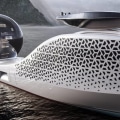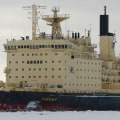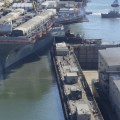Most aircraft carriers do not require routine refueling. The eleven American and French aircraft carriers are nuclear-powered, meaning they can sail continuously without refueling for twenty-five years. The first attempts to refuel and refuel at sea had been made as early as 1870, when the Captain of the HMS Canal Squadron was supplied with coal at a rate of five tons per hour. The speed was too slow to be practicable, and a calm climate was required to keep neighboring ships together.
Although its concept was rejected by the Admiralty, the advantages of such a system became evident to strategists on both sides of the Atlantic. Between 1888 and 1890 alone, more than 20 presentations were made to the RN. The RN embarked on more extensive tests in 1901 and achieved a rate of 19 tons per hour. To meet the requirement of a rate of at least 40 tonnes per hour, Miller implemented a number of improvements, such as improving cable tension maintenance, which allowed it to withstand heavier loads. With the transition to oil as the main fuel for ships at sea, on-going refueling became feasible, as liquid could be pumped continuously, posing fewer problems than transferring solids.
As a result of this test, the Burma greaser, which was launched in 1911, was the first grease gun to be built by order of the Admiralty and was designed to supply oil to destroyers both at sea and in port. In August and September 1911, Burma conducted offshore refueling tests in Portland with the destroyers HMS Mohawk, when 117 tons were transferred, with the HMS Swift, when 270 tons were transferred, and with the HMS Amazon, when 105 tons were transferred. Aft refueling was used again, this time using a hose that ran on wooden rollers suspended on stirrups of a tie rod. A further improvement was the use of a floating rubber hose, which dragged in the sea between the two ships. Despite demonstrating that the concept was viable, the C-in-C Local Fleet reported that the use of tankers to grease destroyers at sea was unlikely to work and that further testing was unnecessary.
As a result, the Royal Navy preferred to continue using fuel in port, rather than at sea until World War II. While during the interwar period most navies pursued refueling destroyers and other small vessels using the side or stern method, it was conventional wisdom that larger warships could not be effectively refueled aft or safely refueled at the stern cost, until a series of tests conducted by In 1939-1940. The now Rear Admiral Nimitz perfected the platforms and handling of the ship, which made it possible to refuel vessels of any size. This was widely used as a logistical support technique in the Pacific theater of World War II, allowing U. S.
aircraft carrier task forces to remain at sea indefinitely. Because it allowed greater range and attack capacity for naval forces, the technique was classified so that enemy nations could not duplicate it. In the 1950s and 1960s, the U. Navy developed a multi-product supply ship that could deliver fuel, ammunition and warehouses while it was underway. These boats saw the introduction of a transfer system that utilizes a ram tensioner that keeps the high line between boats taut, allowing for smooth transfer, as well as taking into account any movement of the boats.
Over time, this method evolved into the standard parallel tensioned refueling (STREAM) method. The Navy also uses other connected refueling methods such as spanwire, bye close in rig and spanline rig platform to transfer. The STREAM platform is preferred over other connected refueling methods as it allows for greater separation between ships. Germany used specialized submarines (so-called dairy cows) to supply hunting submarines in the Atlantic during World War II. They needed both submarines to be stationary on the surface, took a long time to transfer tents and needed to be in radio contact with the refueled ship making them easy targets.
Because of this those that were not sunk soon withdrew from their supply function. While time and effort have been invested in refining ongoing refueling procedures they remain hazardous operations. There are several methods for performing an ongoing replenishment such as Parallel Connected Refueling (CONREP). This is a standard method of transferring liquids such as fuel and fresh water along with ammunition and bulk products.
These boats saw the introduction of a transfer system that utilizes a ram tensioner that keeps the high line between boats taut allowing for smooth transfer as well as taking into account any movement of boats in water. The supply ship maintains a constant course and speed generally between 12 and 16 knots moving at speed reduces relative movement due to wave action and allows better course control. The receiving ship then approaches supplier at distance of approximately 30 yards where provider fires pistol line pneumatic line launcher or firing line which is used to pull through messenger line this line is used to cross other equipment such as distance line telephone line and transfer platform lines. As command ship of refueling operation supply vessel provides all lines and equipment necessary for transfer in addition all commands are directed from supply ship due to relative position of ships it is common for larger ships to install multiple transfer platforms allowing for faster transfer or transfer of multiple types stores.
In addition almost all refueling ships are configured to service two receivers at time with one refueling on each side coupled with connected refueling it is risky operation since two or three boats that circulate side by side at speed must maintain exactly same course and speed for long period time. In addition hydrodynamics of two boats that circulate together causes suction between them slight steering error on part one ships could cause collision due these risks involved connected refueling remains hazardous operation but has been perfected over years allowing aircraft carriers stay sea indefinitely without resupply.



